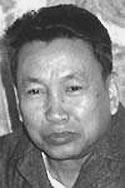Pol Pot
AKA 'Brother Number One'
He was born Saloth Sar on May 19, 1925 and was the son of a prosperous landowner. He was educated in a number of French language schools and at a Catholic college, although he never obtained a high school diploma. In 1949 he went to Paris to study radio electronics but found himself enthralled by the writings of Marx on revolutionary socialism. It's at this time that he becomes friends with other like-minded young Cambodians studying in the area. Oddly enough, this 'Paris student group' became the leaders of the Khmer Rouge under Pot's authority. (Members include: Ieng Sary, Khieu Samphan, Khieu Ponnary, and Song Sen.) Before he was chosen as general secretary to the Kampuchean Communist Party in 1963, he was a teacher for nine years. His former students remember him as a soft-spoken, even-tempered man who loved to recite his favorite poet, Verlaine.
Pol Pot took power on April 17, 1975. In the name of a bizarre blend of peasant romanticism and radical Maoism, the Khmer Rouge conducted an extreme reign of terror intended to give birth to an agrarian utopia. At the point of their guns, the Khmer Rouge emptied Cambodia's cities, abolished money and markets, shut down schools, Buddhist monasteries and forced the entire country to wear black pajamas as a sign of "instant communism".
Those jailed, tortured, and executed were:
1. Anyone who questioned the system
2. Anyone who spoke a foreign language
3. Anyone who wore glasses
4. Parasites such as: intellectuals, teachers, merchants, and doctors.
5. Members of the Lon Nol government
6. Public servants including police and military officers
7. Ethnic Vietnamese
8. Religious leaders - Christian clergy and Muslim leaders
9. Members of the middle class
10. Anyone not working hard enough
11. Anyone complaining about living conditions
12. Anyone collecting or stealing food for personal consumption
13. Anyone wearing jewelry
14. Anyone engaging in sexual relations
15. Anyone grieving over the loss of relatives or friends
16. Anyone expressing religious sentiments
Thousands upon thousands more perished from starvation and disease in the slave camps of the countryside, as the fatally isolated economy ceased to function. Two years later, paranoia reigned and Pol Pot launched a bloody purge against the "hidden enemies, burrowing from within" and had several thousand Khmer Rouge cadres tortured to death in the infamous Tuol Sleng interrogation center. These "strings of traitors" as he saw them, had to be "burned out".
All in all, the devastation upon this country to "purify" Cambodian society of all capitalism was catastrophic and the total number of people killed are estimated to be anywhere from a quarter to a third of the entire population.
On December 25, 1978 Vietnam launched a full scale military invasion of Cambodia, and captured Phnom Penh on January 7, 1979. Pol Pot and the defeated Khmer Rouge retreat to the country's remote western regions from where they would stage a fitful guerilla war destined to last another 20 years. But at least the genocide was over.



